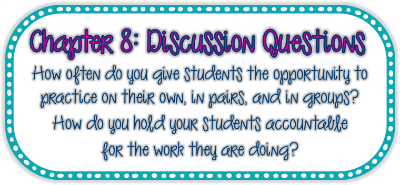Chapter 8 of Guided Math in Action is the chapter that everyone has been waiting for: this chapter is all about centers!

Because most classes are made up of more than the five or six students that work in a small group, a teacher needs to have a plan for what the other students are going to be doing. In a perfect world, all of the students would sit quietly and engage themselves, but that is certainly not the case in any classroom I have been a part of. To do that, the teacher provides the students with centers, or independent activities that the other students can work on while he is teaching a small group.
Dr. Newton begins the chapter by offering some suggestions about how to set up centers and to keep them organized. These are important to use as guidelines because it will help the centers to run smoothly. We all know that students can't breathe on their own without specific instructions, so the better organized your centers are, the smoother the process will go.
It is also suggested that students work in various types of activities throughout the week. These include individual work, partner work, and group work. During individual work, a student is working on an activity by himself without the help of another student or group. In my classroom, this is when students are doing a math sort or working on task cards. There are times where students may work beside other students, but each student is doing his or her own assignment. When my students are working on task cards, they will often share the set of cards, but each student is doing the problem on the card by himself.
During partner work, students are working together with one other student. During this time, they may be working on a project together, such as a puzzle or matching game. In my classroom, my students will often work together on the Monster Match Fact Family Puzzles. They can also play games against their partners. This is a large part of the centers we do in my classroom. An example would be Pirates vs. Ninjas - A Comparing Numbers Game.
During group work, the students are working together with a bigger group of students. This may involve each student having a role in the group. Dr. Newton described each student in the group having a role in solving story problems, such as number cruncher, illustrator, and problem checker. Students can also play competitive games against others in their group. A wonderful teacher named Rachel Lynette has created a set of game boards that she offers for free in her Teachers Pay Teachers store. These boards are excellent for use in group work. My students love playing them.
Dr. Newton also gives a list of the seven centers she believes should be in every math classroom.
- Basic Fact Center - students are practicing math facts.
- Hot Topic Review Center - students are practicing and reviewing skills taught up to that point in the year.
- Geometry Center - students are exploring shapes
- Word Problem Center - students are working to solve story problems at the pictorial, concrete, and abstract level
- Math Poem Center - students are working with math poems and other written materials
- Math Journal Center - students are working on math journals, including foldables and other activities
- Math Vocabulary Center - students are practicing with math vocabulary
Chapter 8 was the most exciting chapter because this is an area that all teachers want to improve in. Dr. Newton offered a number of great examples and ideas for getting centers up and running so that small groups can take place

Question 1: The majority of my math centers are individual activities or partner activities. My students play many math games (especially ones that will help them improve their fact fluency) and work on sorts, cutting activities, or task cards. There are some times when there is group work involved (making graphs, using measurement tools), but not as much as I would like. I hope to make it a goal this year to introduce groups to solving story problems. This may make for a great small group lesson (introducing the procedures and modeling the steps) before adding it as a center.
Question 2: At the present time, my students are accountable for their centers work through something I call the Centers Grid. The centers that we are working on for that time period are listed on a grid. I will often assign three or four "required" centers and allow the students to choose 2-3 others. The majority of the centers have a student recording sheet that goes with the activity (this is especially true of the Scavenger Hunts or task cards). I did like the idea that was introduced in the chapter of calling on students to share what they completed during centers. I am also going to be making reflection sheets for my students to use a few times a week to share what they have done in centers and what they are learning. Dr. Newton provided three different examples of forms, each becoming increasingly more involved. I hope to add reflection like this to my math classroom next year.
School starts in just a few weeks (or days, depending), so I hope you are getting some great ideas from this series on how to run your math class for next year.
Here are some other great blogs to check out their thoughts on this chapter.

No comments :
Post a Comment